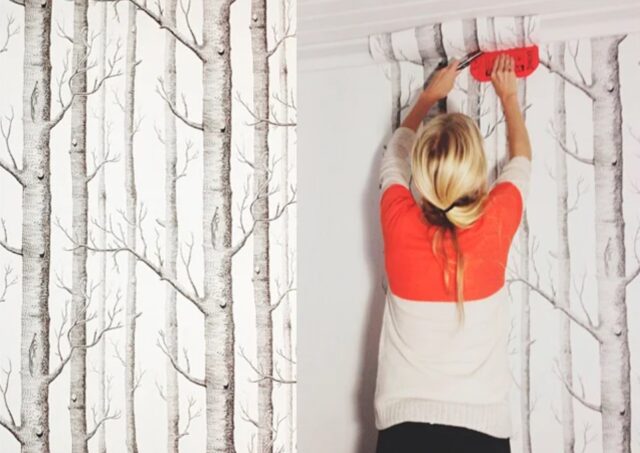If you’re looking for a way to spruce up your home without breaking the bank, consider creating your own wallpaper. It’s easy and can be done in just a few hours, and it is an affordable DIY project that will only cost you $50 or less.
The diy wallpaper peel and stick is a great way to create your own DIY wall paper. It is also very easy to do.
 On Etsy, SammyOnState has a photo.
On Etsy, SammyOnState has a photo.
We had one piece of the jigsaw left to crack after a lengthy and arduous home remodeling effort. We had removed the door off the stairwell going upstairs to help open up our dining area. The bland walls seemed a bit lifeless and needed a pop of something now that the room was open.
Wallpapering has been on my mind since we began our renovation, but I couldn’t bring myself to spend so much money on a design that I may get tired of in a year or two. As a result, I began looking for answers on the internet.
 Madeira Creative Photography took this photo.
Madeira Creative Photography took this photo.
I discovered my solution after a few clicks and an Etsy search: I’d make my own wallpaper! I mean, it can’t be that difficult, right?
… In a way, you’re correct.
We now have “wallpaper” that cost a total of $40 after some early hiccups. You can have it as well! Here’s how to go about it.
Step 1: Look for a pattern.
I began my pattern search on Etsy and whittled it down to the six choices below. I knew I wanted to create something black and white because of our house’s color scheme, but the beauty of these stencils is that you can build any pattern in whatever color you choose!
HeartAndTwig (top left) and HeartAndTwig (top middle). STENCILIT (top right) CuttingEdgeStencils (bottom left) PinkipoDesign is in the bottom middle, while SammyOnState is on the bottom right (my choice).
I chose the herringbone design on the bottom right after much thought, an Instagram vote, and repeated requests from my spouse who couldn’t care less. This is why:
- I thought the upper right and left designs were a bit busy, and that they would clash with our other house décor.
- The bottom left design was and continues to be my favorite. It’s extremely on-trend, and I like how random it is. The herringbone, on the other hand, seemed more timeless and something I wouldn’t grow tired of as soon.
- A buddy also pointed out that the herringbone pattern I chose had an upward movement, making it ideal for a stairwell.
The design arrives as a thin, flexible plastic sheet once you place your purchase. I was concerned at first since it seemed to be low-cost, but it’s flexible for a purpose, I swear.
Step 2: Read the instructions after receiving the pattern!
 Photo courtesy of Amazon
Photo courtesy of Amazon
I nearly missed this step, which would have thrown everything off! I almost began painting over the stencil after thinking I’d be using real paint. That would have been disastrous.
This technique is made much simpler and less messy by using a Sharpie paint pen to fill in the stencils. There are no drop cloths required, and the paint dries fast! These markers are really very cool—not only can they be used to make wallpaper, but I’ve discovered that they can also be used for a variety of other crafts (like coloring a pattern on a canvas bag or a flower pot).
To make things simpler, we removed our stair railing and outlet covers, and the instructions then teach you how to line up the stencil properly so you can create the design in a straight line. It’s almost impregnable.
Step 3: Use a paintbrush to “paint” the design.
By this time, I was beginning to suspect that everything was a bit too wonderful to be true. And I was correct.
There was certainly a learning curve involved. The Sharpie paint markers began to bleed into the wall paint as I began filling in the lines, resulting in less-than-perfect lines (see image below).

This irritated me much, and I attempted to cover it up as soon as possible. These markers, it turns out, don’t like to be painted over immediately after they’ve dried.

Step 3B (Hopefully you won’t have to do this): Please try again!
After repairing the wall paint, I discovered that the key is to paint each rapid stroke in a single pass, without stopping at the start or finish. Instead of coloring in each line like you would in a coloring book, you’ll use the stencil as a guide to draw one fast line with your marker.

I was able to complete the whole area in approximately 2.5 hours after I got the hang of it.
If I had to do it all over again, I would probably pick a less “perfect” design. If I had selected a design that wasn’t so symmetrical, it would have been much easier to hide errors than the one I chose. Mine isn’t flawless, but unless you look closely, you won’t see.
Step 4: Have fun!

We are ecstatic with how the stairwell came out! What’s even better? I can simply paint over it and try again if we grow tired of it.
Best wallpaper for diy is a DIY project that will help you create your own wallpaper. It only takes about 30 minutes to make and costs less than $50. Reference: best wallpaper for diy.
Frequently Asked Questions
How can I design my own wallpaper at home?
You can use a program like Photoshop to design your own wallpaper.
What can I use instead of wallpaper?
You can use the Wallpaper option in the settings menu.
Can you make your own wallpaper?
Yes, you can make your own wallpaper.




